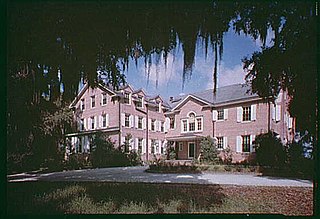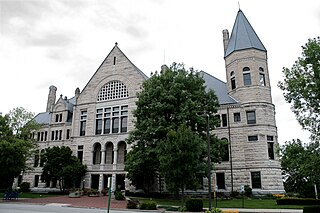
Wayne is a village in DuPage and Kane counties, Illinois, United States. The eastern portion, in DuPage County, is in Wayne Township, while the western portion, in Kane County, is in St. Charles Township. The population was 2,431 at the 2010 census. and 2,425 as a 2018 population estimate.

Orangeville is a village in Stephenson County, Illinois. The town's sign lists the population at 800 as of January 2021. The population in 2020 was 738. The population according to the 2010 census was 793, up from 751 in 2000. Using the 2020 population of 738 Orangeville is the 741st largest city in Illinois and the 11,650th largest city in the United States. Orangeville is currently declining at a rate of -0.94% annually and its population has decreased by -6.94% since the 2010 census. The area's earliest white settlers arrived in the year 1833, and the village was platted in 1851 by John Bower, who is considered the village founder. In 1867 Orangeville was incorporated as a village. The town's central business district contains several 19th century commercial buildings, many of which were built during the railroad boom of 1888–1914. By the time the Great Depression was ongoing, business in Orangeville had started to decline, with the last bank closing in 1932. In 1956 another bank started operating in the village and is still in town today. Some recent infrastructure jumps have restored some of the village's old decor.

Philetus W. Norris was the second superintendent of Yellowstone National Park and was the first person to be paid for that position.

Baddeck is a village in northeastern Nova Scotia, Canada. It is situated in the centre of Cape Breton, where the Baddeck River empties into Bras d'Or Lake.
Army Trail Road is a 16.4-mile (26.4 km) county road in parts of DuPage and Kane Counties, Illinois. Army Trail Road begins at Illinois Route 25 in Wayne and ends at the Addison Village Hall east of John F. Kennedy Drive in a cul de sac in Addison. Parts of Army Trail Road are signed as DuPage County Highway 11 and Kane County Highway 20.

The Dickeyville Historic District is a National Register of Historic Places-listed community located just inside the western edge of Baltimore City, Maryland, near the intersection of Interstates 70 and 695 and adjacent to Kernan Hospital. A small community of about 140 homes and a historic mill, the village is on the banks of the Gwynns Falls and lies at the start of the Gwynns Falls Trail, a 15-mile (24 km) walking and biking trail that is part of the Chesapeake Bay Gateways Network. The village includes two main roads, Wetheredsville Road and Pickwick Road, and three smaller lanes, Hillhouse Road, Tucker Lane and Sekots Road.

Otham is a village and civil parish in the Maidstone district of Kent, England. The population of the civil parish as of the 2011 census is 523, with 204 dwellings.

Buffalo Grove is an unincorporated community in the Ogle County township of Buffalo, Illinois, United States. It was the first settlement in Ogle County, and was once a bustling frontier town that attracted many of Ogle County's early residents. The creation of the Illinois Central Railroad, caused most of the residents and businesses to move to Polo. Today this former hub of business comprises a few dozen homes.

Solomon is a census-designated place in Graham County, Arizona, United States. Its population was 399 as of the 2020 census. It is part of the Safford Micropolitan Statistical Area.

The Philetus W. Norris House is located in Detroit, Michigan, near the corner of Mound Road and Davison Avenue. It was built in 1873 by Philetus W. Norris, who went on to become the second superintendent of Yellowstone National Park. The house was listed on the National Register of Historic Places in 1992 but was substantially destroyed by fire in 2016.
Feura Bush is a hamlet in the town of New Scotland, Albany County, New York, United States. It is in the southeastern corner of the town, along the Bethlehem town-line, eight miles south of Albany. The Feura Bush ZIP Code (12067) includes parts of the town of Bethlehem. It is in the Onesquethaw Volunteer Fire Company fire protection district.

Hobcaw Barony is a 16,000 acres (6,475 ha) tract on a peninsula called Waccamaw Neck between the Winyah Bay and the Atlantic Ocean in Georgetown County, South Carolina. Much of Hobcaw Barony is south of US Highway 17. The land was purchased by the investor, philanthropist, presidential advisor, and South Carolina native Bernard M. Baruch between 1905 and 1907 for a winter hunting retreat. Later, his eldest child, Belle W. Baruch, began purchasing the property from her father beginning in 1936. By 1956, Belle owned Hobcaw Barony entirely. Upon her death in 1964, the property was transferred to the Belle W. Baruch Foundation for a nature and research preserve. The property includes more than 37 historic buildings and structures representative of the eras of both 18th & 19th century rice cultivation and 20th century winter retreats. Hobcaw Barony was named to the National Register of Historic Places on November 2, 1994.

Washington Avenue Historic District is the historic center of Cedarburg, Wisconsin, the location of the early industry and commerce that was key to the community's development. The historic district was listed on the National Register of Historic Places (NRHP) in 1986.
The Galena–Chicago trail was a stagecoach route located in northern Illinois that ran from the mid-to-late 1830s until 1854. As indicated by its name, the route linked Chicago, located in the northeast of the state, with Galena which was located in the lead mining district of the northwest. The Chicago-Galena trail includes the "Stagecoach Trail" that runs between Galena and Lena, Illinois. East of Lena the stage route follows U.S. Route 20 and Business U.S. Route 20 through Eleroy, Freeport and Rockford to Belvidere. This road began as the old State Road number 2 established on 15 January 1836 and laid out by June 1837.

James W. McLaughlin was a Cincinnati, Ohio architect. He studied to be an architect working under famed James Keys Wilson. He fought in the American Civil War serving in the Union Army. During the late 19th century, he became a popular builder in Cincinnati. In 1870 he helped organize the Cincinnati chapter of the American Institute of Architects; that year, he was selected as a Fellow of the AIA, serving on its board.

Oaklawn Farm is a historic property in Wayne, Illinois. The farm was operated by the Dunham family, who successfully bred Percheron horses. The property features the chateauesque Dunham Castle, which was built by Mark Wentworth Dunham in 1880. Nine other buildings from the time period still stand on the property, which is still used as the Dunham Woods Riding Club. The farm was recognized by the National Park Service as a Historic Place in 1979.

Mark Wentworth Dunham (1842–1899) was an American importer and breeder of horses and the owner of the Oaklawn Farm in Wayne, Illinois, which was at one time the largest horse breeding farm in the world.

The Iron County MRA is a Multiple Resource Area addition to the National Register of Historic Places, which includes 72 separate structures and historic districts within Iron County, Michigan, United States of America. These properties were identified and placed on the Register in 1983, with the exception of one property that was placed on the Register in 1993.

Avon Terrace it is the main street of the town of York, Western Australia, and is lined with heritage buildings.

















